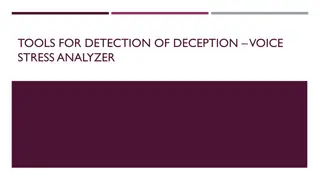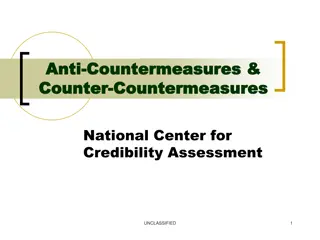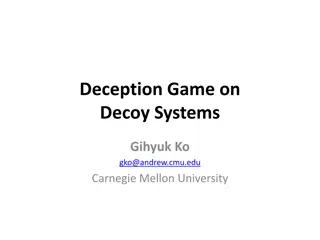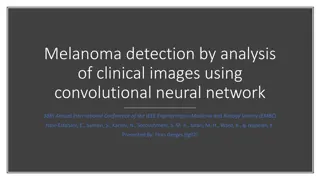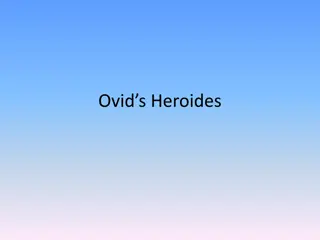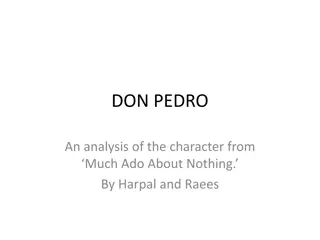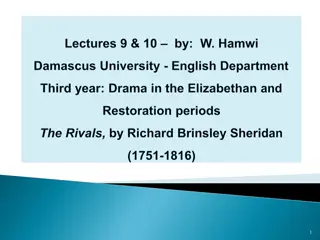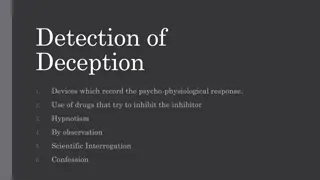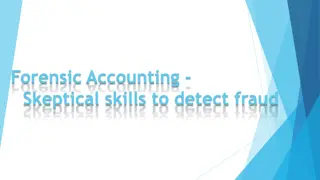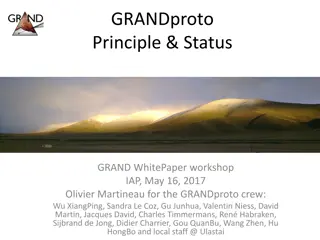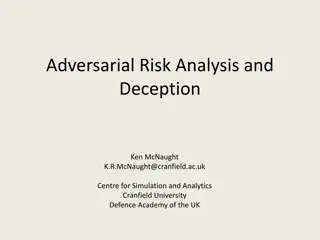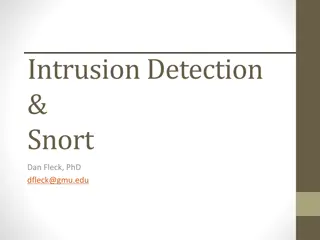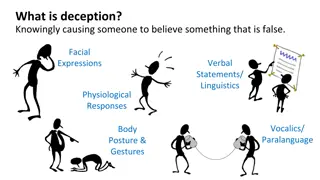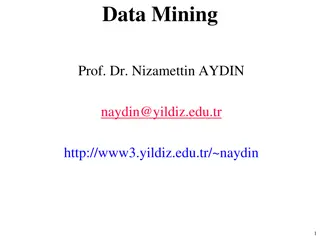Research on Polygraph and Deception Detection
The research focuses on the use of polygraph tests for deception detection, highlighting concerns about accuracy when facing major security threats. It discusses the impact of countermeasures on polygraph screening effectiveness, emphasizing the value of research in detecting deception despite challenges. Various experiments and studies are outlined, presenting insights into the limitations and potential of different methods in this field.
Download Presentation

Please find below an Image/Link to download the presentation.
The content on the website is provided AS IS for your information and personal use only. It may not be sold, licensed, or shared on other websites without obtaining consent from the author.If you encounter any issues during the download, it is possible that the publisher has removed the file from their server.
You are allowed to download the files provided on this website for personal or commercial use, subject to the condition that they are used lawfully. All files are the property of their respective owners.
The content on the website is provided AS IS for your information and personal use only. It may not be sold, licensed, or shared on other websites without obtaining consent from the author.
E N D
Presentation Transcript
CM Research CM Research National Center for Credibility Assessment UNCLASSIFIED 1
The Polygraph and Lie The Polygraph and Lie Detection (2003) Detection (2003) Basic science and polygraph research give reason for concern that polygraph test accuracy may be degraded by CM, particularly when used by major security threats who have a strong incentive and sufficient resources to use them effectively. If these measures are effective, they could seriously undermine any value of polygraph security screening (Page 216) UNCLASSIFIED 2
Comment about Research Comment about Research Mock crimes do not reach the level of jeopardy involved in actual criminal activity Human Use committee mandates that NCCA cannot introduce jeopardy into projects Human Use rules followed by most Universities are not as stringent Research in detection of deception still valuable for a number of reasons UNCLASSIFIED 3
CM Research CM Research Examples of Research Examples of Research Honts, Hodes, & Raskin, 1985; Honts, Raskin, & Kircher, 1987 Honts, 1987; Honts & Amato, 2002 Gudijonsson, 1988 Elaad & Ben-Shakhar, 1991 Honts & Perry, 1992 Honts, Raskin, & Kircher, 1994 Honts, Devitt, Winbush, & Kircher, 1996; Cail-Sirota & Lieberman, 1995 Honts & Amato, 2002 Elaad & Ben-Shakhar, 2009 1. 2. 3. 4. 5. 6. 7. 8. 9. UNCLASSIFIED 4
Honts Honts, , Hodes Hodes & 1985 1985 & Raskin Raskin Experiment 1 CQT format 4 Groups 1 Group Tongue Bite No training 1 Group Toe Press No training 1 Group guilty + 1 Group innocent Experiment 2 CQT format 3 Groups 1 Group Tongue Bite & Toe Press Trained 1 Group Guilty 1 Group Innocent UNCLASSIFIED 5
Honts Honts, , Raskin Hodes Hodes 1988 Raskin, , Kircher 1988 Kircher, , Experiment CQT Spontaneous CM Offered a cash reward for truthful outcomes 60% of guilty self-reported using CM Most frequent spontaneous CMs Controlled breathing and mental relaxation Study concluded that spontaneous CM were not effective in defeating CQT. Experienced examiners unable to detect spontaneous CM UNCLASSIFIED 6
Honts Honts, , Raskin Raskin, , Kircher 1994 1994 Kircher 20 innocent 100 guilty 80 trained in CM Physical CM (Toe Press or Biting the tongue) Mental CM (Counting backwards by 7) CQT Mental and Physical CM equally effective Both CMs defeated the CQT 50% of the time CM difficult to detect on instrument or visually Strongest response usually seen in the CV channel UNCLASSIFIED 7
Elaad Elaad & Ben & Ben- -Shakhar Shakhar, 2009 , 2009 Countering CM in the CIT using Covert Respiration Measures CIT vulnerable to toe pressing and mental CM Interesting Tidbit: Toe pressing activates muscles which results in an enlarged line lengths for the selected foils UNCLASSIFIED 8
CM Research CM Research What is effective What is effective Honts, Raskin, & Kircher, 1994 Suggested Tongue bite effective CM Suggested Toe press effective CM Suggested mental CM (counting backwards by 7s) effective CM Not surprising that all anti-polygraph sites suggest using these CM Do above CM leave a pattern? UNCLASSIFIED 9
CM Research CM Research Spontaneous CM Spontaneous CM Honts, Raskin, Kircher, Hodes, 1988 Otter-Henderson, Honts, Amato, 2002 Honts, Amato, & Gordon, 2001 Honts & Amato, 2002 Honts & Alloway, 2007 1. 2. 3. 4. 5. UNCLASSIFIED 10
Otter Otter- -Henderson, Henderson, Honts Amato 2002 Amato 2002 Honts, & , & 53.8% (43 of 80) guilty performed spontaneous CM 30.0% (12 of 40) innocent performed spontaneous CM Altered breathing, mental CM, biting tongue Results: Spontaneous CM by deceptive participants does not effect polygraph outcomes UNCLASSIFIED 11
CM Research CM Research Spontaneous CM Spontaneous CM Honts & Alloway, 2007 Participants give The Lie Behind The Lie Detector Those programmed innocent and those programmed guilty Participants spent on average 1 hour reading Those that spontaneously performed CM, both innocent & guilty more likely to fail the exam UNCLASSIFIED 12
CM Research CM Research Summarizing the Research Summarizing the Research Both guilty and innocent perform CM Probably more innocent attempting CM One study reveals innocent performing CM may appear guilty Tongue bite, toe presses and mental arithmetic are the CM of choice Multiple CM used by examinees UNCLASSIFIED 13



